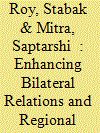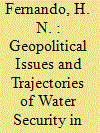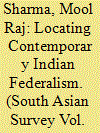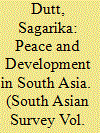|
|
|
Sort Order |
|
|
|
Items / Page
|
|
|
|
|
|
|
| Srl | Item |
| 1 |
ID:
193235


|
|
|
|
|
| Summary/Abstract |
The outbreak of the coronavirus disease in 2019 (COVID-19) wreaked havoc on the social, psychological, economic, and political buoyancy of all economic activities worldwide. The economic challenges caused by the interruption in worldwide economic activities significantly impacted remittances flow to low- and middle-income economies (LMIEs). This study used the past, present, and predicted remittances data of migration dynamics within countries to analyse the economic impact on remittances. Remittances to most LMIEs plunged during the pandemic intense period; however, the decline was temporary as the flows increased due to countrywide policies and individuals’ emergent needs. The trend of economic contagion is fundamentally unique in that even the primary source of remittance sending nations have been greatly impacted. The global nature of this pandemic raises numerous questions, including whether the decline in remittances will continue for a short term or will last for an extended period to stagnate LMIEs. This current study’s results reveal that while remittances flow to key recipient nations declined between 2019 and 2020, there has not been a sharp decrease and most of the nations were on the path of recovery in 2021. This study proposes that policymakers support remittances flow on a higher growth trend in successive years based on Sustainable Development Goals to attain global inclusive development. This research further recommends the adoption of higher technology transfer of remittances of migrant workers within the emerging and low- and middle-income economies.
|
|
|
|
|
|
|
|
|
|
|
|
|
|
|
|
| 2 |
ID:
193238


|
|
|
|
|
| Summary/Abstract |
The primary objective of this study is to assess the practicality and consequences of establishing railway connectivity between India and Myanmar. By exploring the possible impact of this initiative on the relationship between the two countries and regional collaboration, this study aims to shed light on its potential benefits and challenges. The railway network aims to enhance connectivity between the Northeastern states of India and Myanmar, providing a new trade route with Southeast Asia. The study was based on policy review, meta-data analysis, bibliometric literature review and case studies using geospatial techniques. The results indicate that the proposed railway connectivity has the potential to boost trade, tourism and investment and strengthen regional cooperation. However, significant challenges such as security concerns, financial viability and political stability need to be addressed to realise the potential of railway connectivity fully. The study concludes that strong political will, effective project management and public–private partnerships are crucial for the success of the India–Myanmar railway connectivity and its potential impact on bilateral relations and regional cooperation.
|
|
|
|
|
|
|
|
|
|
|
|
|
|
|
|
| 3 |
ID:
193236


|
|
|
|
|
| Summary/Abstract |
In the current academic debate on non-traditional security, the issue of water security has come to the forefront of discussions. This is primarily due to the developing discourse on climate change as a threat multiplier linked with conflicts surrounding access, use, and the management of shared water resources. The Indian subcontinent is therefore an interesting case study where water security and inter-connected security issues have converged as both internal and external security threats. Using the case study of the Indian Subcontinent, this essay serves to enrich the debate on geopolitical challenges and the paths toward achieving water security. The essay provides a general review of the security environment, including the risks and vulnerabilities facing the Indian subcontinent and challenges to water governance arising from both internal and external security concerns, through examples of geopolitical tensions in the region. This includes India, Pakistan, Bangladesh, Afghanistan, Nepal, China, and Tibet (the latter which forms the Hindu Kush Himalaya region). The research leads to the conclusion that institutional structures may be able to reduce regional tensions.
|
|
|
|
|
|
|
|
|
|
|
|
|
|
|
|
| 4 |
ID:
193237


|
|
|
|
|
| Summary/Abstract |
Indian federalism is a peculiar model designed to accomplish the necessities of a heterogeneous and multifaceted society. The constitutional framework of federalism spells out that the fate of the states rests with the centre, as the centre can alter it with consultation but without taking consent from the concerned states. The justification offered for such a design during the Constituent Assembly deliberations was to thwart the centrifugal forces that had caused the partition of the subcontinent. The post-independence issues emerged due to several circumstances that influenced federalism in a political milieu where one party, the Congress, held dominance for the first two decades. This phase of Indian federalism was less contentious than the subsequent phase because of consensual politics but opposition and confrontation later appeared with the rise of oppositional politics and regional autonomy demands. In the 1990s, Indian federalism experienced a shift where regionalisation and federalisation of political parties reshaped the federal context along with other factors. Also, this was a volatile phase followed by a bi-nodal alliance system that brought political stability at the national level. The BJP scripted landmark victories in the 2014 and 2019 Lok Sabha elections that unleashed new challenges and strengthened the trends of centralisation. Besides centralisation, federal cooperation found space through several initiatives of the centre. Thus, the article investigates how Indian federalism functions in a variegated system by emphasising the contemporary trends of centralisation with changing dynamics.
|
|
|
|
|
|
|
|
|
|
|
|
|
|
|
|
| 5 |
ID:
193239


|
|
|
|
|
| Summary/Abstract |
The government as well as a large section of experts claimed that the Look (Act) East Policy (LEP) could become an instrument of economic development for Northeast India through the expansion of trade and investments to the East and Southeast Asian countries. The claim is not only due to the strategic location of Northeast India but also to the abundant resources and potential for trade in the region. In this light, the present paper examines the achievements of Northeast India in terms of expansion of trade and investments during three decades of the LEP. The paper argues that the policy has failed to augment exports and also could not contribute to the economic development of the region as the region still continues to decelerate in socio-economic parameters, largely depending on central grants and aid. Moreover, Northeast India could attract a negligible amount of foreign direct investment even after three decades of economic reforms and the LEP. Finally, the paper also made a reality check of the ‘export-led growth’ strategy for the region, especially under the aegis of Act East Policy, given the stress on ‘connectivity’ development projects with South Asia, East Asia and Southeast Asia, where Northeast India is centrally located.
|
|
|
|
|
|
|
|
|
|
|
|
|
|
|
|
| 6 |
ID:
193240


|
|
|
|
|
| Summary/Abstract |
South Asia has been recognised by the World Bank as an important region in the Global South. It has achieved robust economic growth over the past 20 years which has helped in reducing poverty and improving standards of human development. On the other hand, 36% of the world’s poor live in South Asia, so a lot more needs to be done. This article argues that South Asian countries need peace and stability in order to be able to concentrate on their economic development and achieve the UN’s Sustainable Development Goals. Centuries of colonial rule had led to the impoverishment of the South Asian region and its people. It also created two states, India and Pakistan, that have never had good relations with each other. This has had an impact on regional cooperation and prevented the countries in the region from working together to achieve their developmental goals. The article concludes that while the region needs to sustain high economic growth rates, it does not automatically lead to the reduction of poverty. Other measures have to be adopted to promote the welfare of the people of South Asia.
|
|
|
|
|
|
|
|
|
|
|
|
|
|
|
|
|
|
|
|
|